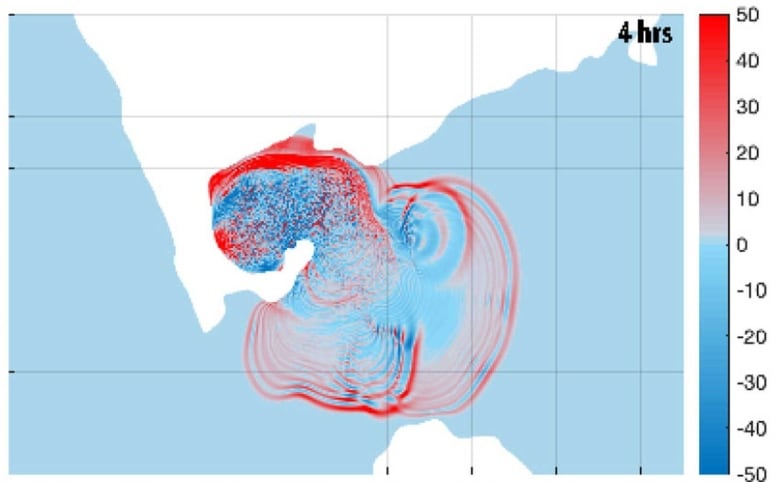ANALYSIS | Computer simulation recreates the giant tsunami that washed over the dying dinosaurs | CBC Radio
The terrible destruction in Canada’s Maritime provinces in the wake of post-tropical storm Fiona, and in Florida from Hurricane Ian, show the incredible power of waves and storm surges many metres above normal, and what they can do to shorelines.
But that damage would pale in comparison to what happened when a wave 1.5 kilometres tall exploded from the Gulf of Mexico 66 million years ago. The wave was a by-product of the catastrophic asteroid impact that led to the extinction of the terrestrial dinosaurs.
Scientists at the University of Michigan have used a computer simulation to reconstruct the tremendous wave that was created when a 14 kilometre-wide asteroid struck the Earth near present-day Chicxulub on the Yucatan peninsula in Mexico.
The 180 km-diameter crater was discovered in 1990 by a team including Canadian geologist Alan Hildebrand. Since then, a great deal of work has been done to learn more about the immediate and long-term effects of the impact.
Some of these effects include disturbance of the sea floor, shock waves causing massive earthquakes, fire storms from the explosion, ash and dust being thrown into the atmosphere causing catastrophic climate disruption, and the mass extinction that followed.
But the details of the effect on the ocean and resulting mega-tsunami had not been accurately modelled until this new study. And what the model showed was itself shocking.

The computer simulation, developed by University of Michigan paleoceanographer Molly Range and her team, showed things were pretty bad, pretty fast.
“At about 10 minutes post-impact we saw that wave at a maximum of about 1.5 km tall, so pretty big,” Range told me, in an interview on Quirks & Quarks.
It then began spreading out through the Gulf of Mexico, like the circular waves radiating out from a stone thrown into a pond. That wave affected coastlines differently, depending on geography, according to Range.
“It starts hitting the coastlines within the first couple of hours. Directly in the Gulf of Mexico, you start seeing waves anywhere from 30 metres in height to hundreds of metres in height. You then start moving out into the north Atlantic [Ocean].”
Quirks and Quarks7:55Painting a picture of the Chicxulub tsunami
It was still at least 10 metres high as it swept up the east coast of North America. The giant tsunami, along with smaller waves created by debris falling from the sky, also propagated across the Atlantic, reaching Europe 24 hours later.
At that time in the Earth’s history, a gap existed between North and South America which allowed the wave to enter the Pacific Ocean. It then spread as far north as Alaska, and halfway around the globe to New Zealand. Even the Indian Ocean was affected as the wave arrived from both the Atlantic and Pacific sides.
Forty-eight hours after the asteroid’s initial impact, most coastlines in the world had been affected by tsunami waves.
While this computer model did not measure how far inland the flooding from these waves would have reached, the scientists did calculate the energy involved.
It was 30,000 times greater than the Indian Ocean tsunami that struck Indonesia in 2004, which killed more than 200,000 people. One can only imagine the destructive force of so much water reaching land.
Supporting evidence for the tsunami’s far-reaching effects lies in ocean sediments that show signs of severe disturbance during that time period. The effects on marine life would have been profound as well. Even with a much smaller event like hurricane Fiona can disturb marine life, thanks to phenomena like dramatic and quick changes in water temperature.
All in all, it was a pretty bad day on planet Earth, and raises existential questions for us, according to Range.
“To think of something like the Chicxulub impact happening today, it’s just hard to quantify,” she said.
VIDEO from the University of Michigan
That impact 66 million years ago was not the first time the Earth has been hit by large objects in space. In fact, all the planets and moons in our solar system show signs of impacts dating back billions of years. The dark circular areas and pockmarked surface of our moon are the result of impacts on our satellite.
There have been at least five major extinction events over the last half billion years — and while we are only sure of one that was triggered by an asteroid impact, each event altered the course of evolution of life. And there are thousands more asteroids and comets still wandering around in space.
But before you worry about the next one heading our way, there is good news. NASA has an ongoing sky survey program called Near Earth Objects Observations Program (NEO) to find, track and characterize at least 90% of objects greater than 140 metres in size. So far, no large dinosaur killers have been spotted heading our way.
If a smaller object is found to be on a collision course with Earth, the recent DART mission showed that we have the capability to send a spacecraft out to intercept an asteroid — and, hopefully, nudge it off-course just enough to miss our planet.
It is ironic that for the first time in the history of life on Earth, we have the ability to prevent a major disruption of of life caused by an object falling from space — but at the same time, many scientists think humans are driving a sixth extinction today through changes we’re making to the planet’s critical habitats with development, pollution and climate change.
For all the latest Technology News Click Here
For the latest news and updates, follow us on Google News.

